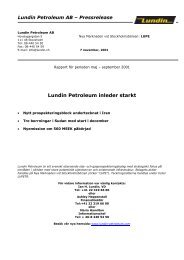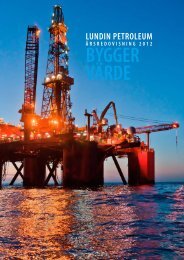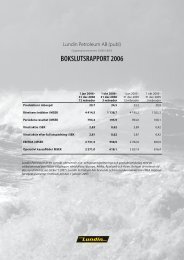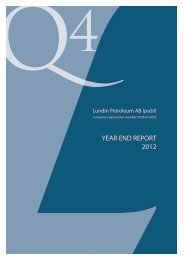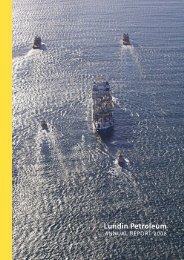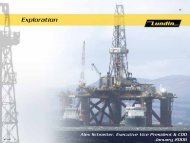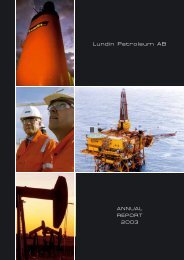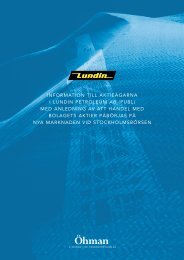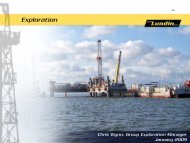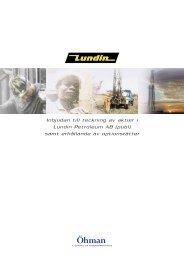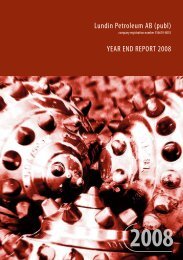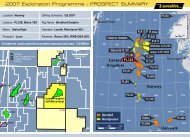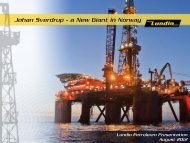Annual Report 2005 (6 MB) - Lundin Petroleum
Annual Report 2005 (6 MB) - Lundin Petroleum
Annual Report 2005 (6 MB) - Lundin Petroleum
Create successful ePaper yourself
Turn your PDF publications into a flip-book with our unique Google optimized e-Paper software.
Classifi cation<br />
Fixed assets, long-term liabilities and provisions consist for the<br />
most part solely of amounts that are expected to be recovered<br />
or paid more than twelve months after the balance sheet date.<br />
Current assets and current liabilities consist solely of amounts that<br />
are expected to be recovered or paid within twelve months after<br />
the balance sheet date.<br />
General<br />
Assets and liabilities are included at their acquisition cost and<br />
nominal amounts respectively unless stated otherwise. Trade<br />
receivables are recognised initially at fair value and subsequently<br />
measured at amortised cost less provision for impairment.<br />
Oil and gas properties<br />
Oil and gas operations are recorded at historic cost less depletion.<br />
All costs for acquiring concessions, licences or interests in<br />
production sharing contracts and for the survey, drilling and<br />
development of such interests are capitalised on a fi eld area cost<br />
centre basis.<br />
Net capitalised costs to reporting date, together with anticipated<br />
future capital costs for the development of the proved and<br />
probable reserves determined at the balance sheet date price<br />
levels, are depleted based on the year’s production in relation<br />
to estimated total proved and probable reserves of oil and gas<br />
in accordance with the unit of production method. Depletion of<br />
a fi eld area is charged to the income statement once production<br />
commences.<br />
Proved reserves are those quantities of petroleum which, by<br />
analysis of geological and engineering data, can be estimated with<br />
reasonable certainty to be commercially recoverable, from a given<br />
date forward, from known reservoirs and under current economic<br />
conditions, operating methods and governmental regulations.<br />
Proved reserves can be categorised as developed or undeveloped.<br />
If deterministic methods are used, the term reasonable certainty is<br />
intended to express a high degree of confi dence that the quantities<br />
will be recovered. If probabilistic methods are used, there should<br />
be at least a 90% probability that the quantities actually recovered<br />
will equal or exceed the estimates.<br />
Probable reserves are those unproved reserves which analysis of<br />
geological and engineering data suggests are more likely than not<br />
to be recoverable. In this context, when probabilistic methods are<br />
used, there should be at least a 50% probability that the quantities<br />
actually recovered will equal or exceed the sum of estimated<br />
proved plus probable reserves.<br />
Proceeds from the sale or farm-out of oil and gas concessions are<br />
off set against the related capitalised costs of each cost centre in<br />
the exploration stage with any excess of net proceeds over all<br />
costs capitalised included in the income statement. A gain or loss<br />
is recognised on the sale or farm-out of producing areas when the<br />
depletion rate is changed by more than 20 percent.<br />
> 53 <<br />
Impairment tests are carried out at least annually to determine<br />
that the net book value of capitalised cost within each fi eld area<br />
cost centre less any provision for site restoration costs, royalties<br />
and deferred production or revenue related taxes is covered<br />
by the anticipated future net revenue from oil and gas reserves<br />
attributable to the Group’s interest in the related fi eld areas.<br />
Capitalised costs can not be carried within a fi eld cost pool unless<br />
those costs can be supported by future cash fl ows from that<br />
fi eld. Provision is made for any impairment, where the net book<br />
value, according to the above, exceeds the estimated future<br />
discounted net cash fl ows using prices and cost levels used by<br />
Group management in their internal forecasting or fair value less<br />
costs to sell. If there is no decision to continue with a fi eld specifi c<br />
exploration programme, the costs will be expensed at the time the<br />
decision is made.<br />
Other tangible fi xed assets<br />
Other tangible fi xed assets are stated at cost less accumulated<br />
depreciation. Depreciation is based on cost and is calculated on a<br />
straight line basis over the estimated useful life.<br />
The carrying amount is written down immediately to its<br />
recoverable amount when the carrying amount is higher. The<br />
recoverable amount is the higher of an asset’s fair value less cost to<br />
sell and value in use.<br />
Non-current assets held for sale<br />
To classify as non-current asset held-for-sale the carrying amount<br />
needs to be assumed to be recovered through a sale transaction<br />
rather than through continuing use. It also must be available for<br />
immediate sale in its present condition and sale must be highly<br />
probable. If classifi ed as non-current held-for-sale the assets will<br />
be valued at the lower of its carrying value and fair value less<br />
estimated cost of sale.<br />
Financial instruments<br />
<strong>Lundin</strong> <strong>Petroleum</strong> recognises the following fi nancial instruments:<br />
■ Loans and receivables are valued at the amounts they are<br />
expected to realise. Translation diff erences are reported in the<br />
income statement except for the translation diff erences on long<br />
term intercompany loans, used for fi nancing exploration<br />
activities, which are taken directly in shareholders’ equity.<br />
■ Other shares and participations (available for sale fi nancial<br />
assets) are valued at fair value and any change in fair value is<br />
recorded directly in shareholders’ equity until realised. Where<br />
the other shares and participations do not have a quoted<br />
market price in an active market and whose fair value cannot be<br />
measured reliably, they are accounted for at cost less impairment<br />
if applicable.<br />
■ Derivative instruments. Derivatives are initially recognised at<br />
fair value on the date a derivative contract is entered into and<br />
are subsequently remeasured at their fair value. The method<br />
of recognising the resulting gain or loss depends on whether<br />
the derivative is designated as a hedging instrument.



